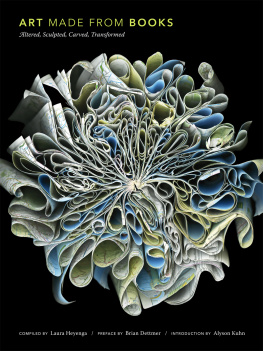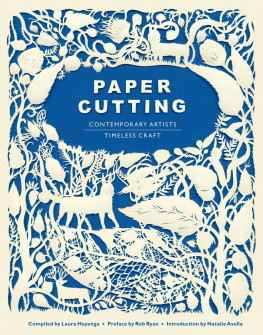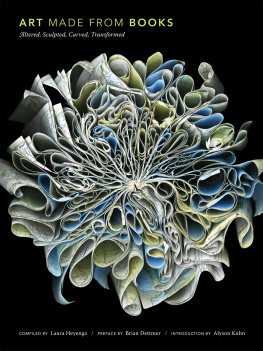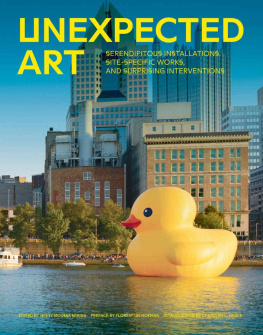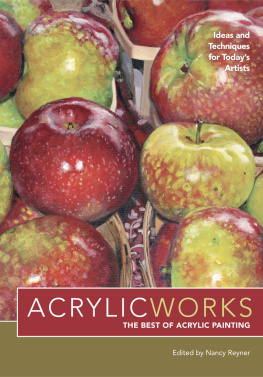
Preface copyright 2013 by Brian Dettmer
Introduction copyright 2013 by Alyson Kuhn
All art copyright the individual artists.
constitutes a continuation of the copyright page.
All rights reserved. No part of this book may be reproduced in any form
without written permission from the publisher.
Library of Congress Cataloging-in-Publication Data available.
ISBN: 978-1-4521-2946-4
Chronicle Books LLC
680 Second Street
San Francisco, CA 94107
www.chroniclebooks.com
CONTENTS

BY Brian Dettmer
BY Alyson Kuhn
ARTISTS


PREFACE
BRIAN DETTMER

I Tower of Babble, 2012, Paperback books, acrylic medium.
I grew up in the eighties right across the street from a school for the developmentally disabled. My brother and I loved to dumpster dive, always out of curiosity rather than necessity. The excitement of exploration was balanced with an equally strong sense of obligation to save valuable items from being thrown away. This sense wasnt merely for the sake of being environmental. It was for the sake of the object, and the potential for its resurrection, revitalization, and rebirth.
Our favorite spot was the cluster of dumpsters behind the school. There were a few times we discovered several dumpsters full of hardbound books. We couldnt believe anyone would throw the books away, and we would gather boxloads to take home to our attic library. They may have been out of date, or useless to us specifically, but we would take them for the titles, the pictures, and often for the actual stories, or sometimes just because it was a book. We had a massive attic library due to our diving.
Encyclopedias were like swimming pools to us. We didnt have our own set but we always knew someone who did. We could politely negotiate a quick swim into the neighbors set or, if we needed a longer swim, we could walk to the library downtown. At the library we could get refreshed and gather interesting ideas from deep within the waves.
The situation has changed.
The book is no longer the king of the information ecosystem. We can now access almost anything instantly online, and bound encyclopedias have become large land mammals that cant compete with the newer species. They have collapsed and they cant go on. Do we feed from the carcass? Ideas, like protein, are valuable and shouldnt go to waste. They should be consumed by someone. Or, do we treat them through taxidermy to preserve them in an inanimate state for future generations to view in museums?
I cut books. I started carving into them around the year 2000. I was working on a series of collages where I began with newspapers and ended up tearing apart books for a fragmented surface of text on the canvas. I felt guilty about what I was doing, but also intrigued by the deep textures and conceptual potential of the printed page. This led me to seal up books, painting the edges of orphaned encyclopediasloners from thrift storesand carving deep holes into them. I was exploring ideas about new ways to approach the pages. At one point I was carving a large hole into a book when I came across a landscape on a page; without thinking I began to cut around the landscape and a figure emerged a few pages below. I carved around that figure and another image appeared. It was exciting because I had no idea what would emerge on the next page. It was like reading. My intuitions were strong and the response was even stronger. I knew I was doing something new and something relevant with old materials. It is recycling, but not just in the material sense; its a recycling of ideas, images, text, and textures from our cultural past. We pull from the past to make something new, the way art always has.
There has been a long tradition of art about the book, of art representing books, of artists books, and even altered books; however, in the last five years I have noticed a huge rise in practicing artists and a more interested audience. Most of this book work has emerged as a result of, or a response to, the rise of the Internet and the fact that the role of books has dramatically changed in our current information ecology. Many nonfiction books, specifically reference books, have lost their original function. But I dont think books will ever die. I think it is the perfect form for many of our ideas and stories. The traditional novel, most fiction, large monographs, art, design, and various other genres of text and image are best in book form because of the quality available in printthe tactility, the functionality, durability, and the authority of the object.
Some books may no longer be as vital as they once were, but like painting at the beginning of our last century, it wont be replaced or even demoted in our cultural hierarchy by a newer form. When photography and high-speed printing became commonplace, people feared and prophesized about the end of painting. But instead of suffocating painting, printing and photography freed painting from its pedestrian responsibilities and allowed it to evolve into newer, more modern directions. The history of modern art, led by the new freedoms of painting, wouldnt be the same without these newer technologies for communication. The same is happening now with the book in the digital age. We have an excess of old material we no longer use and an emergence of new ideas about the book. By altering the book, we can explore the meanings of the material and the idea of the book as a symbol for knowledge. We can explore questions about the history and the future of books and the impact of new technology. We can contemplate and illustrate ideas about literature and information technology.
It is not about nostalgia. It is about the richness of its history and the beauty of its form, though more often it goes far beyond this. The infinite ways a book can be explored with our minds and our tools has just begun. We are at an exciting and pivotal moment in the way we record and receive our information. The form of the book, a symbol for ideas, information, and literature, may be the most relevant signifier and richest material we can work with today. We need to take advantage of this moment and respect the history of the book while contemplating its future in the face of shifts to digital technology.
The book is technology. The book is a machine. The book is food. The book is a body. It is a vast pool we need to dive into. 
INTRODUCTION
ALYSON KUHN
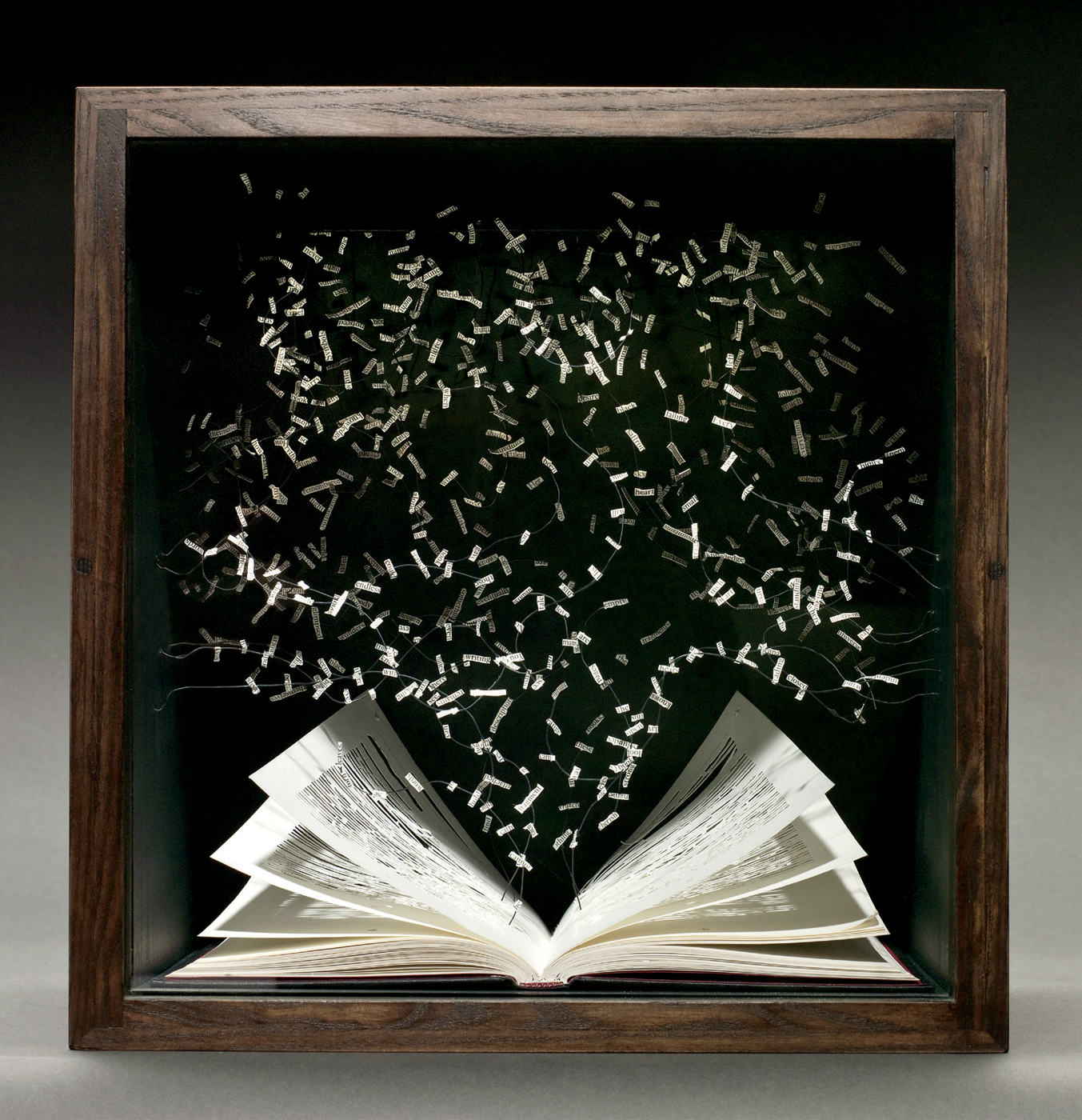
I Su Blackwell, The Book of the Lost, 2011. Secondhand book, lights, glass, wood box.
This anthology showcases the work of artists whose primary material is books. These artists do not make books; rather, they take books apart. Interestingly, a standard nomenclature for this relatively recent art form has yet to emerge. The term altered books is widely used by artists and curators, but many members of the art-appreciating public find it misleading. Doug Beube, who has been altering books for more than thirty years, likes the word
Next page
